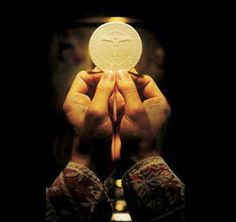The mass is the ultimate and highest prayer of the church. Through the mass, we can be present at Calvary and participate in the redemption of Christ.


Rite of the Mass
The mass begins with the penitential rite. This is a great way to begin the liturgy, because it is important to seek forgiveness before continuing on with the celebration of such a holy rite. Everyone commits sins, even if just venial ones, but God is perfect. Before beginning the main parts of the mass, we should seek His forgiveness for any failings we have had. Next is the readings. This is a very important part of the liturgy, because we hear from God through His written word. There is always a passage from the gospel, and then there is also one or two more readings from either the Old or New Testaments. These scriptures, particularly in concert with the sermon afterwords, will instruct us how to live our lives. It is also a wonderful way to be exposed to the breadth of the Bible. If we attend mass every Sunday, and even more so every day, we will listen to a vast majority of the Bible, and have an understanding of much of Sacred Scripture. After the reading of scripture is the offertory. The bread and wine is brought to the altar and blessed. Eventually this bread and wine will be changed into the body and blood of Christ. After this comes the Eucharistic prayer. This is the high point and most important part of the mass. The Eucharistic prayer is a long prayer offered by the priest. In the middle of the prayer is the consecration of the bread and wine and their changing into the body and blood of Christ. During this prayer he also prays for many intentions. After the Eucharistic prayer is the lead-up to communion. The Our Father is prayed, along with other prayers to prepare the faithful to receive the Lord. After Holy Communion is distributed, there are a few concluding prayers and the people are blessed and dismissed.
The crucial part of the mass is the consecration, or changing of the bread and wine into the body and blood of Christ. Without the consecration, there can be no mass. The mass, and particularly the consecration, is a re-presentation of Christ's sacrifice on Calvary. He is not re-sacrificed, but it is the same sacrifice as that one two thousand years ago, and we are mysteriously present at it every time we attend mass.


Mass is a sacrifice
One of the major criticisms of the mass is that it cannot be the sacrifice of Jesus on Calvary. Either it is a memorial or remembrance of that event, like Passover, or it is a re-sacrifice, and Jesus dies every time the mass is offered. This latter proposition is certainly not the case, although some have accused Catholics of believing that Jesus dies at every mass, and thus dies repeatedly. Jesus died only once for sin, at Calvary on the cross. However, the mass is also more than just a memorial or remembrance. It is indeed a sharing in that sacrifice, so that at every mass, Jesus is not sacrificed again, but it is somehow united with and part of that one sacrifice. This is a great mystery which no one can fully understand. However, it also a great source of joy. The bloody death of Jesus on the cross happened once. It happened outside of Jerusalem, in Israel, approximately two thousand years ago. Since it happened at that particular place and time, almost no one was present, particularly followers of Jesus who lived afterwords, up to and including us today. However, the mass gives us the opportunity to be present at the same sacrifice and to profess our faith just as if we were there at the physical Calvary, for at every mass we somehow are mysteriously present at the foot of the Cross.
The bloody death of Jesus happened once in a particular time and place, but the mass is an unbloodied re-presentation of that sacrifice. A sacrifice involves an offer-er, an offering and a receiver. Both in Christ's death on the cross and in the mass, these three are the same. The offer-er is ultimately Christ. On the cross, Christ offered Himself. At mass, the priest offers the body and blood, but the priest is acting in persona Christi, or in the person of Christ. When he offers the sacrifice, the priest becomes another Christ so that it is indeed Christ offering the sacrifice. The offering or victim is the same, Christ in both circumstances. On the cross it is very clear that Christ is the offering, but in the mass it is not so clear. However, the bread and wine which are offered are turned into the body and blood of Christ, so it is also the body and blood of Christ, Himself, that is offered in the mass. The receiver is also the same: God the Father. These three elements of a sacrifice are the same in both cases, and it is the same sacrifice. Christ does not die many times; he only died once to redeem mankind.
Probably the best way to comprehend this mystery of one sacrifice yet many representations of it throughout the ages is that it is a sacrifice of Heavenly and divine origin. In Heaven, there is no time, and so there is not a sense of past, present or future. On earth we can't imagine how this is possible, since all we have ever known is a world conditioned and dictated by time, but if it is even possible to think of a timeless world, everything would be in the present. Thus, the sacrifice on Calvary and each mass somehow happens all in the present, and yet this is not an adequate explanation they happen outside of time. It is a great mystery which we can never fully understand.
